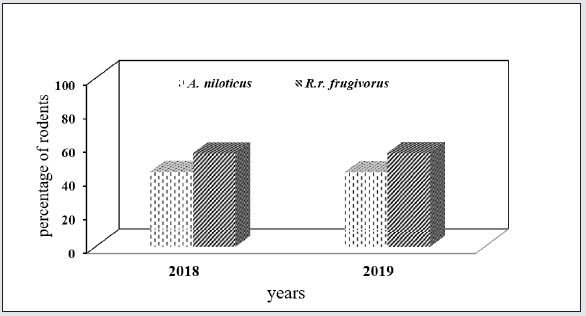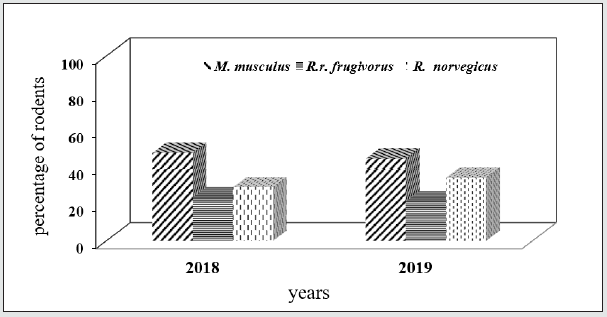
Lupine Publishers Group
Lupine Publishers
Menu
ISSN: 2637-4749
Research Article(ISSN: 2637-4749) 
Studies on The Definition of Rodent Species at Farshut District, Qena Governorate Egypt Volume 4 - Issue 3
Ahmed A A Elrawy1*, Nashaat A Mahmoud1, Saudi A S Baghdadi1 and Abd El-Aleem SS Desoky2
- 1Department of Agric Zoology and Nematology, Faculty of Agric, Al-Azhar University, Egypt
- 2Department of Plant Protection, Faculty of Agriculture Sohag University, Egypt
Received: March 16, 2021; Published: March 26, 2021
Corresponding author: Ahmed A A Elrawy, Agric Zoology and Nematology Department, Faculty of Agric, Al-Azhar University, Assiut, Egypt
DOI: 10.32474/CDVS.2021.04.000186
Abstract
This study was carried out to identify rodent species in the old areas of Al-Dahsa village in Farshout district, Qena governorate, in field crops and buildings during two consecutive years (2018 and 2019). The study revealed the presence of two rodent species (such as Arvicanthis Nilotic us and Rattus rattus frugivorous) in the field crops. While the study revealed the presence of three species of rodents (Mus musculus, Rattus Rattus frugivorous, and Rattus norvegicus) in the buildings. The study also revealed an increase in the density of rodents in field crops in the first and second years as follow: R. r. frugivorous (55.46 and 55.65%), A. Nilotic us (44.54 and 44.35%) for the first and second year, respectively. In buildings, the domestic mouse M. musculus was the most widespread species, accounting for 48.39% and 44.44% of the total rodents trapped for each of the first and second years. It is followed by Rattus norvegicus with 29.03% and 34.19%. R. r. frugivorus was the last species occurring 23.39% and 21.37%. This study is useful for choosing the most appropriate control methods for the rodent species spread in the study area.
Keywords: Field crops; buildings; arvicanthis nilotic us; rattus r frugivorous; rattus norvegicus; m musculus
Introduction
Rodents are global in their distribution and they constitute the largest group of mammals represent nearly 40% of all mammals living at the present time Bajomi [1] surveyed 51 species of rodent in Egypt, belonged to sub-order; Myomorph, eleven species fall under family Muridae, subfamily; Murinae (genera: Arvicanthis, Rattus, Acomys, Mus and Nesoke) are domestic and commensal animals found abundance, while five families are low abundance in desert and semi-desert. Many researchers found in Upper Egypt, Beni-Suif, El Minia, Assiut, Sohag and Qena Governorates the dominant rate species were, R. norvegicus, R. Rattus, A. cahirinus Nilotic’s, M. musculus, Gerbils spp. and Juculus spp. The dominant species and density related to habitats, crop installation, nearly reclamation land and abundance shelter and food and seasons, [2- 7]. The aim of the current study is to know the rodents scattered in the center of Farshout, Qena Governorate.
Materials and Methods
Survey of rodents in old areas at EL-Dahasa village (located at 76 km. North of Qena Governorate), Farshut district, Qena Governorate was carried out in the field crops and a building was carried out during two successive years (2018 and 2019). This area has been planted from a long period with isolated patches of vegetables, wheat, Egyptian clover, palm trees, cattle farm, alfalfa and different orchards as well as a building and a poultry farm. The total wire-box traps were 50 wire-box traps of the usual spring door (25×12×10 cm) in the month. Were baited and distributed at 6pm and examined each morning and the bait was replaced by fresh one. Trapped rodents were transferred to the laboratory for identified according to [8].
Results and discussion
The study revealed the occurrence of two rodent species in field crops (viz., Arvicanthis niloticus and Rattus rattus frugivorus) These rodents belong to family Muridae, Suborder Myomorpha, order Rodentia (Table 1) and (Figure 1). This viz., similar with [9] in sugar cane at Qena Governorate where found that the presence of species of rats included the white bellied rat, R.r. frugivorus, Nile grass rat, A.niloticus and RR Frugivorus the dominant species this may be due to the presence of attributed to the availability of food and shelter as well as prefers trees for nesting in houses. Also, this may be due to the inter-specific competition between this species and other species. The study revealed the occurrence of three rodent species in buildings (viz., Mus musculus, Rattus Rattus frugivorous and Rattus norvegicus) these rodents belong to family Muridae, Suborder Myomorph, order Rodentia (Table 1) and (Figure 2). This data agrees with that obtained by [10] in buildings at Qalubia Governorate (Tukh district) where found that the presence of species of rats included Mus musculus (The house mouse), Rattus rattus (The climb rat) and Rattus norvegicus (The Norway rat). The abundance of rodent species in field crops in the first and second year. Could be arranged quantitatively in the following descending order:
Table 1: Survey of rodent species captured from study areas during two successive years at Qena Governorate, for 2018- 2019 years.

Figure 1: Percentage of rodent species in the field crops during two successive years at Qena Governorate.

Figure 2: Percentage of rodent species in the buildings during two successive years at Qena Governorate.

a) The White bellied rat, R. r. frugivorous (55.46and 55.65%
for the first and second year, respectively).
b) The Nile grass rat, A. niloticus (44.54 and 44.35% for the
first and second year, respectively).
In the buildings, the house mouse M. musculus was the most
dominant species constituting 48.39% and 44.44% of the total
trapped rodents for both first and second year. Followed by the
Norway rat Rattus norvegicus 29.03% and 34.19%. The white
bellied rat R. r. frugivorous was the last species of occurrence
23.39% and 21.37% (Table 1). It may be concluded that the
availability of preferred food in both areas led the rats to feed, and
produce higher reproduction rat in both areas, wholly in agreement
with the findings obtained by [11-12].
References
- Hoogstral H (1963) A brief review of contemporary land mammals of Egypt (including Sinai) 2 lagomorpha and Rodentia. J Egypt Pub Hlth Assoc 38: 1-34.
- Salit AM, Helal TY, Ali MA, Abdel Gawad KH, Arafa MS (1982) Composition of the rodent species in newly reclaimed semi-desert area comparing with cultivated land. Assiut Journal of Agric Sciences 13(2): 53-62.
- Abazaid AA (1990) Efficiency of some commonly used rodenticide and some new alternatives against rodents in Qena Govern-orate. MSc Thesis Fac Agric Assiut Univ, Egypt pp: 93.
- Hussien SSM (1991) Ecological studies and control of certain rodents in Beni suef Governorate. MSc Thesis Fac of Agric Cairo Univ, Egypt.
- El Deeb HI, Lokma HE (1992) Field studies on population dynamics and reproductive biology of the Nile rat Arvicanthis niloticus. Zagazig J Agric Res 19(3): 1431-1435.
- Embarak MZ (1997) Ecological control studies on Rodents and their ectoparasites in cultivated and Newly Reclaimed area. MSc Thesis Fac Agric Assuit Univ pp: 130.
- Desoky ASS (2007) Management strategies for rodents within different Ecosystems. MSc Thesis Fac Agric Assiut Univ Assiut Egypt pp: 124.
- Osborn DJ, Helmy I (1980): The contemporary land mammals of Egypt (including Sinai). Published by field museum of National Historg London field and Zoolgy New series Nol's pp: 569.
- El Khayat AEE (2010) Ecological and biological studies on some species of rodents. MSc Thesis Fac Agric Benha Univ Benha Egypt pp: 161.
- Abdel Gawad KH, Farghal AI, Salman AG, Maher Ali A (1987) Survey and population density of rodent species in some urban, rural and cultivated areas in Sohag Governorate. Upper Egypt Assiut J Agric Sci 18 (1): 259-266.
- El Feky MA (1990) Studies on small rodents and their fleas’ species of public health importance in Sabahiya Experimental Station with special reference to their control. MSc Thesis Fac Agric Alex Univ Egypt pp: 113.
- Bajomi D (1984) Commensal rodent problems in Hungry Organization and practice of vertebrate pest control Hampshire Conference England p. 18-20.

Top Editors
-

Mark E Smith
Bio chemistry
University of Texas Medical Branch, USA -

Lawrence A Presley
Department of Criminal Justice
Liberty University, USA -

Thomas W Miller
Department of Psychiatry
University of Kentucky, USA -

Gjumrakch Aliev
Department of Medicine
Gally International Biomedical Research & Consulting LLC, USA -

Christopher Bryant
Department of Urbanisation and Agricultural
Montreal university, USA -

Robert William Frare
Oral & Maxillofacial Pathology
New York University, USA -

Rudolph Modesto Navari
Gastroenterology and Hepatology
University of Alabama, UK -

Andrew Hague
Department of Medicine
Universities of Bradford, UK -

George Gregory Buttigieg
Maltese College of Obstetrics and Gynaecology, Europe -

Chen-Hsiung Yeh
Oncology
Circulogene Theranostics, England -
.png)
Emilio Bucio-Carrillo
Radiation Chemistry
National University of Mexico, USA -
.jpg)
Casey J Grenier
Analytical Chemistry
Wentworth Institute of Technology, USA -
Hany Atalah
Minimally Invasive Surgery
Mercer University school of Medicine, USA -

Abu-Hussein Muhamad
Pediatric Dentistry
University of Athens , Greece

The annual scholar awards from Lupine Publishers honor a selected number Read More...




